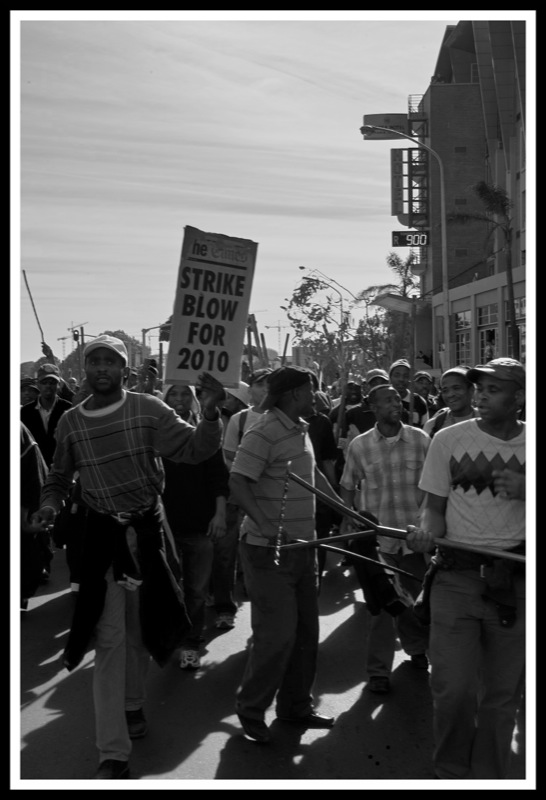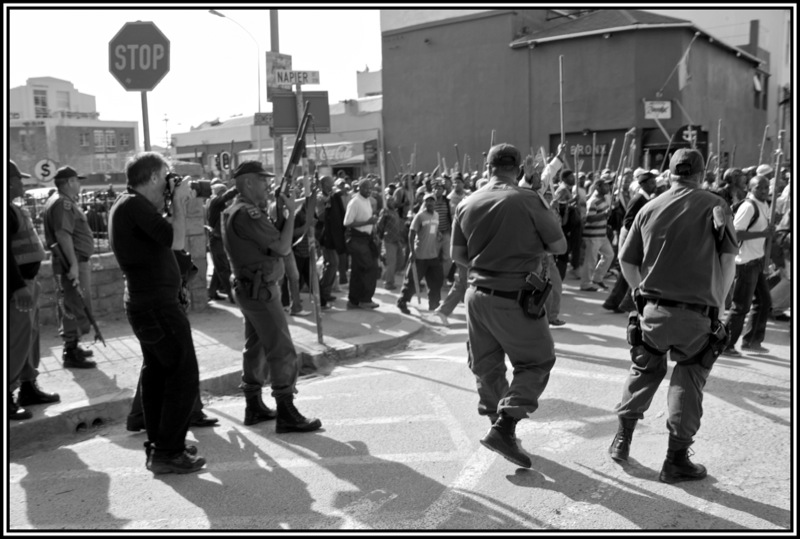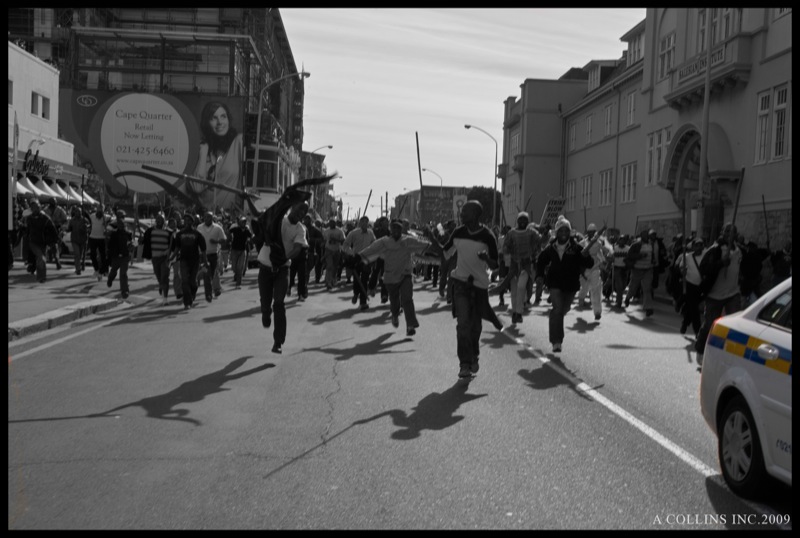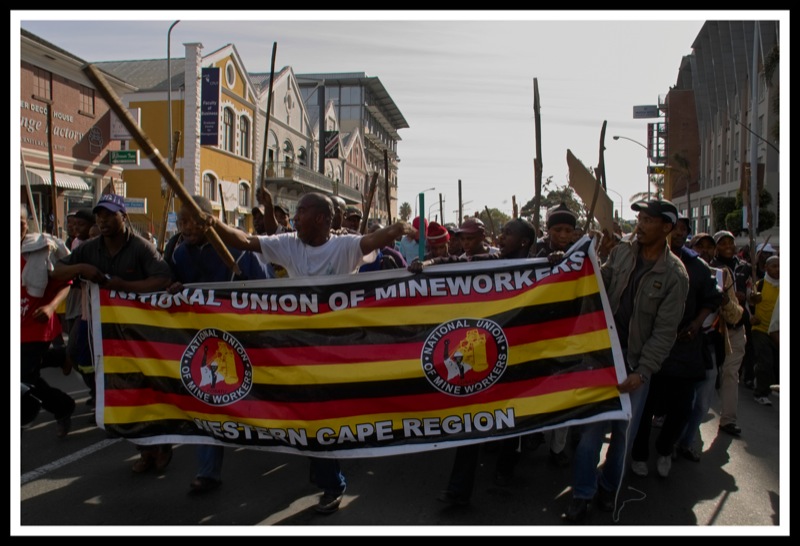As we predicted in earlier articles on the April 2009 elections, working class communities throughout South Africa are rising up and demanding that the state gives attention to the appalling conditions they are working and living in. Everywhere workers are striking demanding better wages and working conditions.
Karl Marx once noted that if history repeats itself for the first time it is a tragedy, if it does so for a second time it is a farce. Louis Napoleon Bonaparte’s overwhelming election victory in France at the end of 1848 represented a peasant rebellion against the republic of the rich. Napoleon was the only man who ‘exhaustively represented the interests and the imagination of the peasant class, newly created in 1789.’ However, Napoleon also caught the imagination of the proletariat, the petite bourgeoisie and the bourgeoisie. Marx concluded that ‘the most simple minded man in France acquired the most multifarious significance. Just because he was nothing, he could signify everything, save himself.’
Jacob Zuma swept to power in the African National Congress (ANC) in November 2007 at its Polokwane Conference. At this conference the influence of the working class and the poor from ANC branches in general, but also those loyal members of the Congress of South African Trade Unions (COSATU) and the South African Communist Party (SACP) held sway over the scheming conspiracies of the cynical and aloof Thabo Mbeki faction. However, while the working class and the poor firmly believed that the ANC under new leadership would lead them out of the neo-liberal dead end that Mbeki had led them into, Zuma also had significant petite bourgeois and bourgeois support from those fractions of the ruling class that felt excluded from the feeding frenzy that occurred under Mbeki, particularly with regard to the privatisation of state enterprises, the issuing of affirmative procurement contracts, and the structuring of Black Economic Empowerment (BEE) deals with the mining industry.
 Construction worker strike at Green point world cup stadium in Cape Town. Photo by collins m gituma on flickr. While this alliance of class interests would hold in the election of a new ANC leadership at Polokwane in 2007 given the common objective of dislodging the Mbeki faction, and in the April 2009 re-election of the ANC, its unity is severely threatened by the economic and political realities facing South Africa in a global recession, and in deciding which of these class interests would become dominant once the new administration assumed office. While the bourgeoisie is fighting its struggle through the media and has secured significant victories in retaining Trevor Manuel in a senior ministerial position of planning, in the appointment of bean counter Pravin Gordhan as Minister of Finance and have forced the ANC to retain the ‘sound economic and financial policies’ of the Mbeki era, the working class and the poor have responded with strikes and community protests.
Construction worker strike at Green point world cup stadium in Cape Town. Photo by collins m gituma on flickr. While this alliance of class interests would hold in the election of a new ANC leadership at Polokwane in 2007 given the common objective of dislodging the Mbeki faction, and in the April 2009 re-election of the ANC, its unity is severely threatened by the economic and political realities facing South Africa in a global recession, and in deciding which of these class interests would become dominant once the new administration assumed office. While the bourgeoisie is fighting its struggle through the media and has secured significant victories in retaining Trevor Manuel in a senior ministerial position of planning, in the appointment of bean counter Pravin Gordhan as Minister of Finance and have forced the ANC to retain the ‘sound economic and financial policies’ of the Mbeki era, the working class and the poor have responded with strikes and community protests.
As we predicted in earlier articles on the April 2009 elections, working class communities throughout South Africa are rising up and demanding that the state gives attention to the appalling conditions they are working and living in. Everywhere workers are striking demanding better wages and working conditions. A week after communities in Diepsloot, Balfour and all over the North West Province, protested, municipal workers have joined by striking for a 15% wage increase. On Monday 27 July and Tuesday 28 July striking workers on the march in all the major cities of South Africa clashed with police and trashed central business districts. The South African Local Government Association (SALGA) initially offered 9%, but is now offering 13%. Municipal workers such rubbish collectors earn roughly ZAR 42 000 per annum (ZAR 3500 per month). Executive Directors in local government earn around ZAR 1 million per annum, Municipal Managers earn around ZAR 1.6 million per annum. No wonder South Africa is one of the most unequal societies in the world!
The bourgeois media, including the state run SABC are all condemning the trashing of the city centres, and are calling on workers to reconsider their excessive demands in the face of the current global recession, however these calls seem empty of moral content given that newly appointed government ministers are trawling the showrooms for luxury car brands in purchasing their official transport, one vehicle for Cape Town and another for Pretoria. Unlike most other countries where there is a central car pool for government vehicles, with a single standard model for all ministers, ministerial transport in South Africa has been outsourced and each minister can choose the vehicle model of his or her preference! No doubt this was done in an effort to cut costs and in the interests of applying sound bourgeois business principles to governance!
South Africa is the richest country in Africa. It is responsible for 50% of the economic output of the continent. It is richly endowed with minerals such as platinum, platinum group minerals, gold, uranium, iron, coal, copper and diamonds. It is also the country with the biggest wealth gap in the world, along with Brazil and Botswana. The country also has, along with Botswana and Swaziland, the highest HIV/AIDs infection level in the world.
 Construction worker strike at Green point world cup stadium in Cape Town. Photo by collins m gituma on flickr. It is a country of huge contrasts with the leafy suburbs around Sandton, such as Sandhurst and Houghton, north of Johannesburg accommodate the super rich ruling class have amongst the highest per capita income levels in the world, contrasted to informal settlements (squatter camps such as Diepsloot, Ramaphosa, Freedom Park and shacks teetering on the edge of the Jukskei River and radioactive streams such as the Wonderfonteinspruit). Not to speak of moneyless remote rural areas in the Eastern Cape, the North West Province and the Northern Cape, where people are too poor to afford newspapers or transport to go to towns to look for jobs.
Construction worker strike at Green point world cup stadium in Cape Town. Photo by collins m gituma on flickr. It is a country of huge contrasts with the leafy suburbs around Sandton, such as Sandhurst and Houghton, north of Johannesburg accommodate the super rich ruling class have amongst the highest per capita income levels in the world, contrasted to informal settlements (squatter camps such as Diepsloot, Ramaphosa, Freedom Park and shacks teetering on the edge of the Jukskei River and radioactive streams such as the Wonderfonteinspruit). Not to speak of moneyless remote rural areas in the Eastern Cape, the North West Province and the Northern Cape, where people are too poor to afford newspapers or transport to go to towns to look for jobs.
Since January 2009 more than 500 000 people have lost their jobs and more than 750 000 have joined the ranks of the permanently unemployed.
Any person who claims that the instrument of class analysis is no longer relevant only needs to visit South Africa, the spatial realities of contrasting poor and super rich, proletarians and bosses, are only to obvious to the naked eye. Freedom Park sprawls like an ugly sore of human misery in the shadow of Implats mine shafts; Ramaphosa, the site of vicious xenophobic attacks on Mozambican mine workers in May 2008 is surrounded by booming gold mines (given the current gold price which is approaching US$1000 per ounce). The cause of the resentment is the meagre mineworker income of ZAR 1500 for surface workers, and ZAR 3000 for underground workers, (roughly US$180 and US$375 per month respectively). Consider that the average CEO in South Africa took home ZAR 5.35 million per annum in 2006, a 145 times more than the average worker. The average salary for a mining CEO was R6,6-million. The CEOs of dual-listed mining companies Anglo American, BHP Billiton, Lonmin and Sappi brought home the most money as they received foreign-currency-denominated packages. The largest salary in the sector went to Chip Goodman, CEO of BHP Billiton amounting to R29,5-millon.
Instead of workers being united in class struggle against this system of capitalist inequality and exploitation, they are fighting over the meagre crumbs falling from the bountiful table of the bosses. This is reminiscent of anti Jewish pogroms in Russia in the 19th and early 20th centuries. The cause of the violence against foreign migrant mine workers is exactly the fact that the biggest mining corporations in the world, BHP Billiton, Anglo Gold Ashanti, Anglo Platinum, Implats, Lonmin and Lonplats are too stingy to afford their workers descent family accommodation on mine property. The mines import most of their labour and hide this fact behind subcontracting and the “living out allowance” which is a sum of between R1000 and R1500 given to workers who are prepared to live off mine property. Workers see this as additional to their meagre salaries, and because there are housing shortages in formal townships, because rent is high and because transport costs to and from townships to mines are expensive workers in themselves living in shacks in squatter camps. High levels of unemployment amongst locals give rise to a virulent sex trade and levels of sexually transmitted diseases and HIV/AIDs that is out of control in such informal settlements. Shebeens, gambilng and trade in alcohol also flourish in these conditions. Generally, local communities have to degrade themselves to share in this meagre income stream. Given the current global economic crisis cost containment on the mines will be in the form of retrenchments, less money spent on mine health and safety programs and cutting down on environmental and social spending, all for the sake of maintaining profit margins.
 Construction worker strike at Green point world cup stadium in Cape Town. Photo by collins m gituma on flickr. High on election promises and by what they saw as the possibilities of the defeat of the Mbeki clique at Polokwane voters turned out in their millions to return the African National Congress and its alliance partners, the South African Communist Party and COSATU (the Tri-Partite Alliance) to power in the April 2009 elections. The poor hoped that Polokwane would mark a shift in government policy away from the neo-liberal stance of the previous ten years. However, as soon as the new government took office it began backtracking. The ANC Youth League and the Young Communists in the SACP called for the Nationalisation of the mining industry. A leader of the Young Communists remarked that the Minerals and Petroleum Development Act governing mining was “an instrument used by the political elite, to activate the political elite to enrich the economic elite!” The ANC leadership, including Ben Turok, one of the “authors” of the Freedom Charter quickly moved to point out that ‘nationalisation is not what the Freedom Charter called for’. And here the working class laboured under the misconception for five decades that the Freedom Charter was the product of the will of the people, drawn up at the Congress of the People in Kliptown in June 1955!
Construction worker strike at Green point world cup stadium in Cape Town. Photo by collins m gituma on flickr. High on election promises and by what they saw as the possibilities of the defeat of the Mbeki clique at Polokwane voters turned out in their millions to return the African National Congress and its alliance partners, the South African Communist Party and COSATU (the Tri-Partite Alliance) to power in the April 2009 elections. The poor hoped that Polokwane would mark a shift in government policy away from the neo-liberal stance of the previous ten years. However, as soon as the new government took office it began backtracking. The ANC Youth League and the Young Communists in the SACP called for the Nationalisation of the mining industry. A leader of the Young Communists remarked that the Minerals and Petroleum Development Act governing mining was “an instrument used by the political elite, to activate the political elite to enrich the economic elite!” The ANC leadership, including Ben Turok, one of the “authors” of the Freedom Charter quickly moved to point out that ‘nationalisation is not what the Freedom Charter called for’. And here the working class laboured under the misconception for five decades that the Freedom Charter was the product of the will of the people, drawn up at the Congress of the People in Kliptown in June 1955!
The working class and the poor of South Africa are sick of living in proximity of the urban waste dumps of the rich and powerful, they are sick of breathing the dust of mine waste that tower in close proximity to the squatter camps. They have had enough of living in tin shacks that are freezing in winter and ovens in summer. The working class and the poor have had enough of not having access to services such as descent education, health, housing, water, electricity and waste removal, they reject having to be last in line and are demanding the attention of the state. The questions which the poor are posing cannot be resolved by capitalism, it is a system which can only worsen these challenges.
Will the Tri-Partite Alliance heed the voice of the working class and the poor in the now very visible class struggle, (unions demanding better wages and working class communities demanding services) or will they continue to appease the capitalist ruling class hoping to be included in the next lucrative black economic empowerment (BEE) mining deal? Or will the leaders of SACP and COSATU five years from now plead that they have been caught unawares. As Marx said of France under Louis Bonaparte “A nation and a woman are not forgiven the unguarded hour in which the first adventurer that came along could violate them. The riddle is not solved by such turns of speech, but merely formulated differently. It remains to be explained how a nation of thirty-six millions can be surprised and delivered unresisting into captivity by three swindlers.”
July 29, 2009
